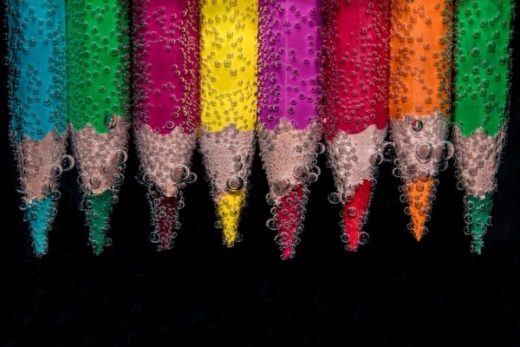Innovation Thinking: Exercising Your Creative Muscle
— December 11, 2018

Myriams-Fotos / Pixabay
From Coco Chanel to Arianna Huffington, Jeff Bezos to Howard Schultz, many of the great business innovators of our time were all creative thinkers. The biggest myth about creativity is that it is an inherent talent—you must be born creative. But the truth is that creativity is a discipline that can be learned and honed.
At its simplest, creativity is the process of turning new and imaginative ideas into reality. It’s a process of thinking, and then producing. The end product can take the form of an extraordinary painting or musical composition, or a revolutionary new product, or even something banal yet innovative, like a more efficient operations process in a factory.
There are five key skills that most creative and innovative individuals have honed:
- Associating: the ability to connect seemingly unrelated questions, problems, or ideas from different fields;
- Questioning: the constant asking of provocative questions that challenge common wisdom and the status quo;
- Observing: the observation and then scrutiny of the behaviors of other people, places, and systems to identify new ways of doing things;
- Experimenting: construction of interactive experiences that try to provoke unorthodox responses and deliver useful insights;
- Networking: meeting of people with different kinds of ideas and perspectives.
Like all skills, they need to be practiced, over and over again, until the behaviors become ingrained or automatic.
Associating
Some of the biggest breakthroughs in innovation come from random associations—for example, Steve Jobs’ chance encounter with a calligraphy class eventually led to the beautiful typography that Apple computers would become known for. Building these connections requires two key things: a curiosity for the world, and a bit of divergent thinking.
One of the best things you can do to build this skill is to feed your curiosity constantly—take classes, read books, try new hobbies, visit new places, learn a new language. Even a small bit of knowledge and experience in something completely new can spark a completely “random” idea later.
When it comes to divergent thinking, you can exercise your association skills through games such as random word brainstorming, or even better, build your skills with a group through improv classes for professionals.
Questioning
One of the most important things you can do as a business leader is to ask questions. However, it’s not quantity that matters, it’s quality—in short, better questions beget better answers.
How do you get in the habit of asking the right questions? Start by challenging assumptions, then using those answers to propose new ideas—try to go from “Why?” to “What If?” Why do we spend 20% of our marketing budget on television ads? Why is that the best solution? What if we moved it to social media ads?
Running out of ideas on what to ask? Try the 20 questions exercise from LifeLabs. Pick a random object (a pen, a desk lamp, etc.) and write down 20 questions about that object in three minutes. Around question 10-12, the brain naturally shifts to “innovation mode”; this is where you’ll see a shift in the quality of questions. Do this exercise for five days straight, and eventually you’ll be asking better questions more naturally.
Observing
Observation is one of the hardest skills to master, mainly because we are so easily distracted. Most days we prefer to bury ourselves in work or stare into a smartphone than pay attention to the world around us. Observation requires patience, time, and creative space—all things we tend not to allow ourselves in our fast-paced lives.
The simplest way to train yourself to be more observant is to take a walk. Leave the phone behind (at least confine it to your pocket) and allow yourself to meander with no specific destination in mind. Spend time observing the people around you. Contemplate the big picture and scrutinize the small details. Look for patterns. Close your eyes and pick out individual sounds you hear.
To take it one step further bring a sketchbook and draw what you see. Or take that phone out of your pocket (just quickly!) and take a snapshot of a detail or scene that was interesting to you.
Experimenting
To be great at experimenting means being able to accept and learn from failures just as much as successes. Amazon has a famous culture of experimentation that allows employees to act on ideas and try lots of prototypes, even if they are giant flops. Out of these flops came surprise hits, like Amazon Kindle and Amazon Prime.
How can you become more experimental? Try giving yourself rules and limits on projects. As Marissa Mayer famously said while working at Google, “creativity loves constraints.” Rules challenge us to break them, and limits force us to think outside the box.
Embrace experimentation outside of the office as well and take on projects that have nothing to do with work. Maybe it’s building a treehouse with the kids, or hosting a fundraiser for your local community center.
Networking
There’s networking you do to boost your business and career, and networking you do to become more creative. The two are quite different. Networking for business often means meeting others in the industry and building contacts who are typically similar to you.
Networking for creativity means making a conscious effort to meet people with different backgrounds and from different walks of life. This can mean attending events that bring together diverse minds (like TED talks), volunteering at a nonprofit, or even just making a point to strike up a conversation with a random stranger you meet on your travels.
Allow yourself to get out of your comfort zone and let yourself be inspired by unique perspectives and ideas from others. You never know what sort of creative associations you’ll be able to build upon later!
A version of this post originally appeared here.
Business & Finance Articles on Business 2 Community
(20)


